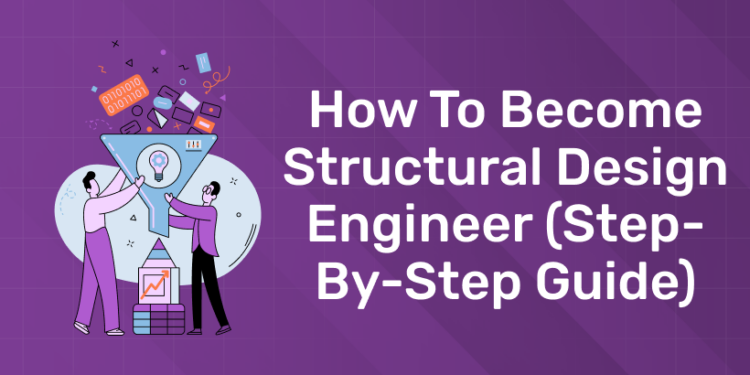Table of Contents
A structural design engineer is an engineering specialist whose role revolves around designing and assessing structures, ensuring their robustness and stability. They check the durability of materials and the integrity of buildings, bridges and other large structures. Learning more about becoming a civil engineer opens up a new arena of career opportunities and helps you make an informed decision about whether this is the right path for you.
A construction designer is a professional designer who helps design plans for large structures. They ensure that the structure is sound, including the foundation, walls and pillars. They can also help to try to restore the security of a pre-existing structure. Structural designers can work on everything from apartment complexes to dams or large sculptures.
How to Become Structural Design Engineer
Structural Design engineering is a branch of civil engineering that deals with the design and analysis of structures. Becoming a civil engineer, it requires a some education and training process that involves several steps.
1. Earn a Bachelor’s Degree in Civil Engineering
The first step to becoming a civil engineer is to earn a bachelor’s degree in Civil Engineering from an accredited institution. Coursework in construction includes mathematics, physics, structural analysis, material science and construction management. The degree program usually takes four years to complete.
2. Gain Work Experience
After getting a bachelor’s degree in Civil Engineering, civil engineers need work experience. Many graduates work as civil engineers in construction companies, government agencies or engineering consultancies. Gaining work experience allows graduates to apply theoretical knowledge in practice, which is key to becoming a successful structural engineer.
3. Earn a Master’s Degree in Structural Engineering
Bachelor’s degree in civil engineering provides a solid foundation. Many civil engineers pursue a master’s degree in civil engineering to get a specialized knowledge in the profession. Coursework in the Master’s program focuses on advanced static analysis, structural design and earthquake engineering. The program usually takes two years to complete.
4. Obtain a Professional Engineering (PE) License
In order to become a licensed civil engineer in the US, individuals must obtain a Professional Engineering (PE) license. This license is issued by the NCEES (National Council of Examiners for Engineering and Surveying). Requirements to obtain a PE license vary by state, but typically include passing the Fundamentals of Engineering (FE) exam, completing a specified number of years of experience, and passing the Professional Engineering (PE) exam.
Build A Career In Structural Engineering! Get Free Demo Classes!!
5. Continue Education and Professional Development
Structural engineering is a rapidly evolving field, and in order to remain competitive, structural engineers must keep abreast of the latest developments and advancements. Continuous education and professional development are essential for success in the field. Civil engineers can attend conferences, workshops, and seminars, and participate in professional organizations to stay current and connected.
6.Online Structural Design Engineering Courses
When choosing the right civil engineering online certificate course, students should look for programs that align with their career goals, time commitment, financial investment requirements, and industry trends. Online courses, in particular, often allow professionals to learn at their own pace, making them a practical choice for career advancement.
Continuous learning is essential in the dynamic and ever-evolving field of civil engineering. Whether you are a recent engineering graduate or a seasoned professional, courses can help you shine in the profession and stand out from the competition.
The Structural Design Course by Entri is tailored for structural engineers who want to advance their career and secure high-paying office jobs in India and abroad. It equips students with the necessary skills and knowledge to thrive in this dynamic field. The program offers comprehensive training and hands-on experience that will prepare students for success in civil engineering.
1: What is the primary purpose of structural design?
Different Careers To A Structural Engineer
There are several professions that share similarities with the civil engineer role in that they include design, construction and inspection duties. Here is a list of jobs that are similar to civil engineer:
1. Civil Engineer
National Average Salary: ₹ 3,11,831 per year
Primary Responsibilities: Civil engineers design, construct, supervise, operate and maintain large construction projects and systems. This includes roads, buildings, airports, tunnels, dams, bridges, water supply and wastewater treatment systems.
2. Mechanical Engineer
National Average Salary: ₹ 2,76,038 per year
Primary Responsibilities: Mechanical engineers design, develop, manufacture, and test mechanical and thermal sensors and devices, including tools, motors, and machines. These engineers often work on power-generating machines.
3. Electrical Engineer
National Average Salary: ₹ 2,83,183 per year
Primary Responsibilities: Electrical engineers work to design, develop, test, and supervise the production of electrical equipment such as electric motors, radar and navigation systems, or power generation equipment. They also design electrical systems for vehicles and aircraft.
4. Architect
National Average Salary: ₹ 6,89,628 per year
Primary Responsibilities: Architects create the overall aesthetics and appearance of buildings and other structures, but their work involves much more than sketching designs. They ensure that the building is functional, safe, cost-effective and meets the needs of the people who will use it.
Build A Career In Structural Engineering! Get Free Demo Classes!!
Purpose of Structural Design in Civil Engineering
In 1981, two suspended walkways collapsed during a tea dance at the Hyatt Regency Hotel, Missouri, USA. The main reason for this collapse was a design flaw – one set of threaded rod hangers supported both walkways; the design could not support the weight and collapsed.
Structural design analysis is therefore essential to avoid potential disasters and to ensure that the design is stable, durable and able to withstand the expected loads. Structural engineers use structural design to determine the forces that can act on a structure and select materials and bracing to strengthen the structure.
The purpose of structural design in the construction industry is multifaceted. Check out the key purposes below
1. Built and Design
The structural design of the building directly affects the service life and stability of the structure. Building a structure without consideration of its layout carries the risk of collapsing under its weight. Structural design helps determine key factors such as foundations, walls, floors, steep beams, material quality, etc., which ensures that the constructed structure is safe and sound. Essentially, structural engineers work on aesthetic design principles to design structures that withstand loads and pressures.
2. Safety and Compliance
Structural design analysis ensures that the structure meets the necessary structural regulations and safety requirements. In-depth analysis helps make informed decisions about the load a structure can carry, the wind speed it can withstand, and its overall capability in other environmental conditions. For example, structural design analysis could have helped avoid the Hyatt Regency disaster.
3. Construction Material
The material used for the construction of the structure guarantees its operational usability and safety. Structural design helps select the most appropriate resources and materials for construction to ensure the stability of the structure throughout its intended life.
Conclusion
In conclusion, becoming a civil engineer in the US requires dedication, hard work, and a commitment to lifelong learning. The above steps provide aspiring civil engineers with a blueprint to follow as they pursue their career goals. With the right education, experience, and licensure, civil engineers can design and analyze the structures that shape our built environment, ensuring safety, durability, and sustainability for years to come.
For more details about the course, visit Entri Structural Design Course.
Frequently Asked Questions
What is Structural design engineering?
Structural design engineering includes creating plans for structures, analysing them, and ensuring they are safe and functional.
Are there opportunities for specialisation in this field?
Structural engineers can specialise in seismic, bridge, or sustainable design.
What is the salary of structural design engineers?
Structural Design Engineer salary in India ranges between ₹ 2.0 Lakhs to ₹ 9.5 Lakhs with an average annual salary of ₹ 4.2 Lakhs.















